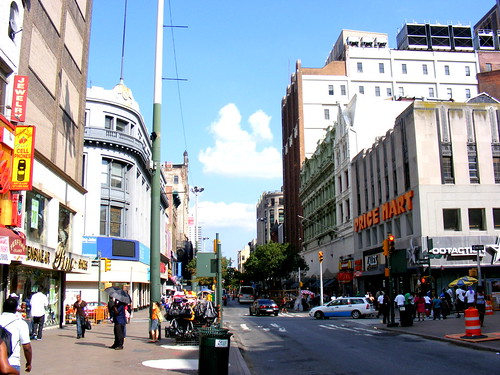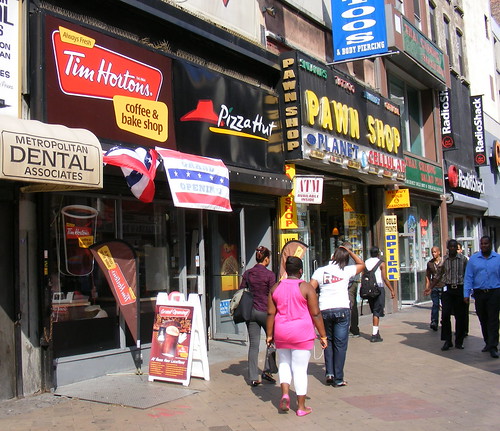1. Is it broken?
2. Fix it for whom?
The department store was king in the early years, anchoring the retail street with the kind of opulence that sold social identity along with cuff links and trousers. Fulton Street, conveniently situated at a major transit hub, became the destination for white middle-class Brooklynites. However, this all changed with the demographic shifts and rise of the suburban retail malls. Black and Puerto Rican shoppers began to outnumber white shoppers, and before long the whites who did show up would come in through the back and avoid Fulton altogether.
The department store owners were nervous and began to search for ways to reinvent the shopping street to meet their picture of success. This included closing it down to private vehicles and implementing some basic streetscaping. The interesting twist, however, is that Fulton was throughout this period, and remains to today, an incredibly popular and highly profitable retail corridor. In fact, it's still by some measures the third most financially successful commercial street in the country, with ground floor rents commanding over $200 a square foot. The national chains have stayed away because the rents are too expensive. The authors suggest that the perpetual calls to "revitalize" Fulton may be more situated in particular cultural values than anchored to actual numbers,
"Fulton Mall continued to be judged not by the literal value of the goods sold but by the cultural value that the mainstream applied to them, thus trapping its public image as a failure. Given these terms, what could success look like?"
 Rosten Woo surmises that the real motivation behind the various revitalization schemes has not been to create a more successful retail environment, but rather to create a public amenity attractive to the new affluent white residents moving in to the brownstones and condos around it. This situates the Fulton Mall right in the middle of the heated Brooklyn gentrification debates, only it's shoppers not tenants who are being threatened with displacement.
Rosten Woo surmises that the real motivation behind the various revitalization schemes has not been to create a more successful retail environment, but rather to create a public amenity attractive to the new affluent white residents moving in to the brownstones and condos around it. This situates the Fulton Mall right in the middle of the heated Brooklyn gentrification debates, only it's shoppers not tenants who are being threatened with displacement.To be perfectly honest, the street, as it stands, really does break a lot of the design principles planners usually work with. There are buildings with historic character that are covered with false facades. Many of the signs seem to be trying to scream louder than the one next door. The stadium-style lighting does little to define the character of the place. There's few places to sit and congregate. Upper floors are boarded up, and many of the property owners are reportedly absentee. Not much for mixture of uses. The Business Improvement District is in the process of overhauling the streetscape and addressing many of these concerns.
In other ways, Fulton performs very well by most planners' criteria, with an incredible diversity of small-scale shops that have grown up organically around each other, some of the best transit access there is, and plenty of interesting transparent ground floors to keep the attention of pedestrians. There are a fair number of street trees. These are all assets the BID does not have any intention of doing away with.
But the question this book raises is a very searching one: are these values that we typically espouse as good placemaking culturally contingent or are they widely shared across cultures? Just as Robert Venturi attacked the standard negative aesthetic reaction to suburban strip development in the 1970's, Street Value asks how we can be learning from Fulton rather than trying to change it. From this perspective, attempts to improve a place may really have a subtext of shifting power and ownership from one group to another - in this case from blacks traveling in from Bedford-Stuyvesant to the whites moving into adjacent Brooklyn Heights.
I'm personally less willing to travel all the way down Venturi's path toward cultural relativism. One hint of a more unified aesthetic is a survey of shoppers administered by the Pratt Center for Community Development researchers a few years ago. One of their findings:
71% of our respondents considered FultonMany of the problems mentioned above were also cited by the mostly black shoppers given the survey. The authors of Street Value may go too far in their assumptions that the black community wants Fulton to stay as it is. Even the construction cones are praised as interventions positively contributing to Fulton's grittiness by keeping it in constant flux. Language like this is out of sync with the instinctive tastes of any culture. It's probably better to fix things quickly and move the cones away as soon as possible, I would think. It might not be too naive to envision a place like Fulton Mall serving both of the communities around it in with a consensus of some values and a kind of ad hoc compromise for those values that do diverge. It need not be a zero sum game.
Street Mall, “an important place that could be improved”; a further 17% considered it, “an important place that should continue just as it is.”
Quibbles aside, the book does drive home a few good, general lessons.
- Historic preservation is more than just restoring pretty buildings; places get embedded with social meaning and the collective memories of those who use them. Nostalgia is a strong emotion that should be accounted for in any planning decision.
- The scope of gentrification reaches beyond housing and into the changes that take place in public and commercial spaces.
- Design is probably less important than designers make it out to be. Any physical space can be successful with enough access and prior social momentum from a community.







2 comments:
Historic preservation is more than just restoring pretty buildings, and it is more than just nostalgia. Historic preservation, at its core, is about asserting a sense of place - when people believe that sense has been lost - usually for the intent of increasing economic vitality. That's why you HPres is so strong in small towns right now - because each one feels that it's special and seeks to reprove it by looking to their past. In this case, though, HPres would probably take a different form: not interfering with the mall's evolution. Fulton Mall already has a well-defined sense of place. You could make it prettier, but is that necessary?
As always, thoughtful and multi-sourced... Dang,...now that you're out of school, I see we are going to get some of that post-grad school bling to pump up your all-encompassing curiosity, double-treatments and musings. What a treat!
I need to go check out Fulton Street. Still a place on my discovery path. From the sounds of it, I know the kind of place described. The striking feature of these kinds of streets to me is centrality and liminality...being central but also being between destinations and between different neighborhoods. These places are helped (though not necessarily beholden to) the fact that, at one point or another, inconvenient places to switch between lines and modes of transit are present. There's a stretch involved between connections, either walking, transit-hopping or driving.
Central Square in Cambridge, MA is exactly this kind of place for similar reasons (and also a place that has haltingly "gentrified"). In Central Square's case, the main street is a "zipper" in the fabric, not providing straight connections for most of the crossing through traffic. At the same time, Central Sq. provides a convergence point for transit routes. These conditions do benefit storefronts, but they like to demand more attention anyway by adding visceral "interest".
Post a Comment